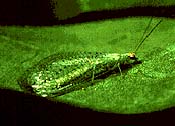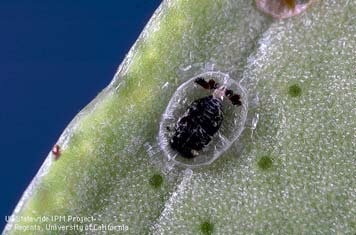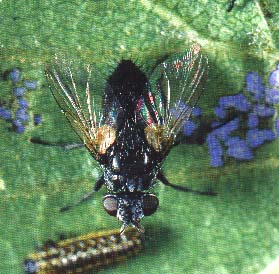Click
here for the Adobe Acrobat (pdf) Version of This Page, in full color
with more pictures!
Plants That Attract Beneficial
Insects
Nature is filled with "good bugs", crawling and
flying creatures whose diet consists mainly of the pests that ravage
garden plants. Here is a list of those good bugs and the plants that
they like to visit for food and shelter. Intersperse these plants
among the "problem pest areas" in your yard. Remember, though: Many
chemical sprays work on both bad and good bugs. To keep the good bugs
in your yard, eliminate insecticide use in the areas where they live
and work. Our thanks to Steve Zien of Living Resources Company for
helping to match up the good bugs with good homes. For more
information about beneficial insects, there are two wonderful books
(which include the pictures below) from the University of California
Press, both written by UC Davis Entomologist Mary Louise Flint:
"Pests of the Garden and Small Farm" and "The Natural Enemies
Handbook".
LACEWINGS (Chrysopa spp.)
Beautiful little green or brown insects with
large lacy wings. Individual white eggs are found laid on the ends of
inch-long stiff threads. It is the larvae (which look like little
alligators) that destroy most of the pests. They are sometimes called
aphid lions for their habit of dining on aphids. They also feed on
mites, other small insects and insect eggs.

The lacewing, which is also attracted to well-lit windows and
screens on spring and summer evenings.
Plants that attract lacewings:
|
Achillea filipendulina
Fern-leaf
yarrow
Anethum graveolens
Dill
Angelica gigas
Angelica
Anthemis tinctoria
Golden
marguerite
Atriplex canescens
Four-wing
saltbush
Callirhoe involucrata
Purple
poppy mallow
Carum Carvi
Caraway
|
Coriandrum sativum
Coriander
Cosmos bipinnatus
Cosmos
white sensation
Daucus Carota
Queen
Anne's lace
Foeniculum vulgare
Fennel
Helianthus
maximilianii Prairie
sunflower
Tanacetum vulgare
Tansy
Taraxacum officinale
Dandelion
|
|
|
|
LADYBUGS
Recognized when they are adults by most
gardeners. However, the young larvae, black with orange markings, eat
more pests than the adults, and they can't fly. Yellowish eggs are
laid in clusters usually on the undersides of leaves.

Plants that attract ladybugs:
|
Achillea filipendulina
Fern-leaf
yarrow
Achillea millefolium
Common
yarrow
Ajuga reptans
Carpet
bugleweed
Alyssum saxatilis
Basket of
Gold
Anethum graveolens
Dill
Anthemis tinctoria
Golden
marguerite
Asclepias tuberosa
Butterfly
weed
Atriplex canescens
Four-wing
saltbush
Coriandrum sativum
Coriander
Daucus Carota
Queen
Anne's lace
Fagopyrum esculentum
Buckwheat
|
Foeniculum
vulgare Fennel
Helianthus
maximilianii Prairie
sunflower
Penstemon strictus
Rocky Mt.
penstemon
Potentilla recta
'warrenii' Sulfur
cinquefoil
Potentilla villosa
Alpine
cinquefoil
Tagetes tenuifolia
Marigold
- lemon gem
Tanacetum vulgare
Tansy
Taraxacum
officinale
Dandelion
Veronica spicata
Spike
speedwell
Vicia villosa
Hairy
vetch
|
HOVERFLIES
Also known as syrphid fly, hover fly or flower
fly. Adults look like little bees that hover over and dart quickly
away. They don't sting! They lay eggs (white, oval, laid singly or in
groups on leaves) which hatch into green, yellow, brown, orange, or
white half-inch maggots that look like caterpillars. They raise up on
their hind legs to catch and feed on aphids, mealybugs and
others.

Plants that attract hoverflies:
|
Achillea filipendulina
Fern-leaf
yarrow
Achillea millefolium
Common
yarrow
Ajuga reptans
Carpet
bugleweed
Allium tanguticum
Lavender
globe lily
Alyssum saxatilis
Basket of
Gold
Anethum graveolens
Dill
Anthemis tinctoria
Golden
marguerite
Aster alpinus
Dwarf
alpine aster
Astrantia
major
Masterwort
Atriplex canescens
Four-wing
saltbush
Callirhoe involucrata
Purple
poppy mallow
Carum Carvi
Caraway
Chrysanthemum
parthenium Feverfew
Coriandrum sativum
Coriander
Cosmos bipinnatus
Cosmos
white sensation
Daucus Carota
Queen
Anne's lace
Fagopyrum esculentum
Buckwheat
Foeniculum vulgare
Fennel
Lavandula angustifolia
English
lavender
Limnanthes douglasii
Poached
egg plant
Limonium latifolium
Statice
|
Linaria
vulgaris
Butter and eggs
Lobelia erinus
Edging
lobelia
Lobularia maritima
Sweet
alyssum - white
Melissa officinalis
Lemon
balm
Mentha pulegium
Pennyroyal
Mentha spicata
Spearmint
Monarda fistulosa
Wild
bergamot
Penstemon strictus
Rocky Mt.
penstemon
Petroselinum
crispum
Parsley
Potentilla recta
'warrenii' Sulfur
cinquefoil
Potentilla villosa
Alpine
cinquefoil
Rudbeckia fulgida
Gloriosa
daisy
Sedum kamtschaticum
Orange
stonecrop
Sedum spurium &
album Stonecrops
Solidago virgaurea
Peter Pan
goldenrod
Stachys officinalis
Wood
betony
Tagetes tenuifolia
Marigold
- lemon gem
Thymus serpylum
coccineus Crimson
thyme
Veronica spicata
Spike
speedwell
Zinnia elegans
Zinnia -
liliput
|
PARASITIC MINI-WASPS
Parasites of a variety of insects. They do not
sting! The stingers have been adapted to allow the females to lay
their eggs in the bodies of insect pests. The eggs then hatch, and
the young feed on the pests from the inside, killing them. After they
have killed the pests, they leave hollow "mummies."
Braconid wasps feed on moth, beetle and fly
larvae, moth eggs, various insect pupae and adults. If you see lots
of white capsules on the backs of a caterpillar, these are the
braconid cocoons--leave the dying caterpillar alone!
Ichneumonid wasps control moth, butterfly,
beetle and fly larvae and pupae. Trichogramma wasps lay their eggs in
the eggs of moths (hungry caterpillars-to-be), killing them and
turning them black.

The black dot in the middle of the picture is an emerging encarsia
wasp, which is hatching out of an immature stage of a (now dead)
whitefly. The wasp lays its eggs onto young whiteflies.
Plants that attract parasitic
mini-wasps:
|
Achillea filipendulina
Fern-leaf
yarrow
Achillea millefolium
Common
yarrow
Allium
tanguticum
Lavender globe lily
Anethum
graveolens
Dill
Anthemis tinctoria
Golden
marguerite
Astrantia major
Masterwort
Callirhoe involucrata
Purple
poppy mallow
Carum Carvi
Caraway
Coriandrum sativum
Coriander
Cosmos bipinnatus
Cosmos
white sensation
Daucus Carota
Queen
Anne's lace
Foeniculum vulgare
Fennel
Limonium latifolium
Statice
|
Linaria vulgaris
Butter
and eggs
Lobelia erinus
Edging
lobelia
Lobularia maritima
Sweet
alyssum - white
Melissa officinalis
Lemon
balm
Mentha pulegium
Pennyroyal
Petroselinum crispum
Parsley
Potentilla recta
'warrenii' Sulfur
cinquefoil
Potentilla villosa
Alpine
cinquefoil
Sedum kamtschaticum
Orange
stonecrop
Tagetes tenuifolia
Marigold
- lemon gem
Tanacetum vulgare
Tansy
Thymus serpylum
coccineus Crimson
thyme
Zinnia elegans
Zinnia -
liliput
|
TACHINID FLIES
Parasites of caterpillars (corn earworm,
imported cabbage worm, cabbage looper, cutworms, armyworms), stink
bug, squash bug nymphs, beetle and fly larvae, some true bugs, and
beetles. Adults are 1/3 to 1/2 inch long. White eggs are deposited on
foliage or on the body of the host (in the picture below, the
tachinid fly is approaching the larvae of an elm leaf beetle). Larvae
are internal parasites, feeding within the body of the host, sucking
its body fluids to the point the pest dies.

Plants that attract tachinid flies:
|
Anthemis tinctoria
Golden
marguerite
Fagopyrum esculentum
Buckwheat
Melissa officinalis
Lemon
balm
Mentha pulegium
Pennyroyal
|
Petroselinum crispum
Parsley
Phacelia tanacetifolia
Phacelia
Tanacetum vulgare
Tansy
Thymus serpyllum
coccineus Crimson
thyme
|

MINUTE PIRATE BUGS (Orius spp.)
Tiny (1/20 inch long) bugs that feed on almost
any small insect or mite, including thrips, aphids, mites, scales,
whiteflies and soft-bodied arthropods, but are particularly attracted
to thrips in spring.

DAMSEL BUGS (Nabis spp.)
Feed on aphids, leafhoppers, plant bugs, and
even small caterpillars as adults and nymphs (teenagers). They are
usually dull brown and resemble other plant bugs that are pests.
Their heads are usually longer and narrower then most plant feeding
species (the better to eat with).

BIG EYED BUGS (Geocoris spp.)
Small (1/4 inch long), grayish-beige, oval
shaped) bugs with large eyes that feed on many small insects (e.g.,
leaf hoppers, spider mites), insect eggs, and mites, as both nymphs
and adults. Eggs are football shaped, whitish-gray with red
spots.
Plants that attract minute pirate bugs, damsel
bugs and big eyed bugs:
|
Carum Carvi
Caraway
Cosmos bipinnatus
Cosmos - white
sensation
Foeniculum vulgare
Fennel
Medicago sativa
Alfalfa
|
Mentha spicata
Spearmint
Solidago
virgaurea
Peter Pan goldenrod
Tagetes tenuifolia
Marigold
- lemon gem
|
back to Farmer Fred home
page







